 ARTIST
ARTIST
 ARTIST ARTIST |

"Ex-LMS 'Patriot' 4-6-0 No.45510 stands on the turntable at Camden MPD during the 1950s"
Original for sale (Framed): £1150
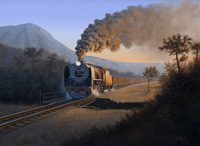
A class 25NC 4-8-4 hauls a freight somewhere in South Africa.
Original now in a private collection in Gloucestershire.
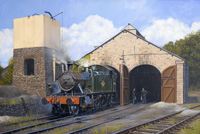
Based on a photo by Peter Gray (with permission).
Original now in a private collection in Gloucestershire.
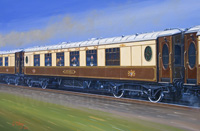
Painted for use as a book cover illustration, due for publication soon.
Original now in a private collection in Wiltshire.
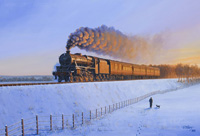
Preserved Black 5 No. 45379 hauls a passenger train round Wanders Curve en route to Alton on the Mid-Hants railway.
The painting is featured on the railway's 2011 Christmas card.
The original painting is now part of a private collection in Worcestershire.
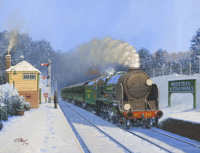
No. 850 'Lord Nelson' arrived at Medstead and Four Marks with a passenger service for Alresford on the Mid-Hants railway.
The original painting is now part of a private collection in Chicago.
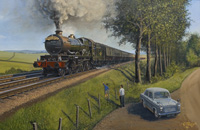
This painting is now part of a private collection in Surrey.
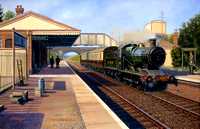
During a summer evening sometime in 1947, Collett '2251' Class 0-6-0 No.3205 is depicted at Toddington with a local passenger service from Honeybourne to Cheltenham, with a horsebox at the rear for the racecourse station.
The painting was commissioned by a gentleman involved with the 2251 Locomotive Fund, owners of 3205 in preservation.
3205 has visited the Gloucestershire & Warwickshire Railway (which operates from Toddington station), in preservation, and would have been a likely visitor to the line during GWR days. Toddington station today is restored to a condition that closely matches that of the 1950s. Therefore I was fortunate with being able to visit the station to accumulate reference material for the painting.
An interesting point concerns the tender depicted in the painting, which is of a different design to that which is paired with the locomotive in preservation. The locomotive actually had the tender seen in the painting until the mid-1950s when, following damage in an accident, the tender was exchanged for the current example. Originally in the painting I had depicted the incorrect, preserved version of tender and when the error was realised I had to change the tender to the authentic pattern.
The majority of work on this painting was done from a studio near Toddington, and I crossed that very bridge seen in the painting to travel there!
The original painting is part of a private collection in Somerset.
Prints of this painting will be available shortly from the 2251 Locomotive Fund. Proceeds from the sale of these prints will help fund the current overhaul of 3205 at the South Devon Railway. Click here for more details.
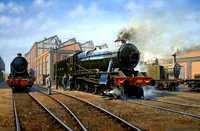
During August 1945 Hawksworth's prototype 4-6-0 express passenger locomotive No.1000 (later to become the 'County' class), was out-shopped from Swindon Works. These locomotives followed the familiar Swindon tradition of GWR 2-cylinder 4-6-0s, but featured plate-frame bogies, continual splashers, straight nameplates, and a higher boiler pressure. The 'Counties' were the last class in a line of locomotives that could trace their roots back to the 'Saint' class.
Locomotives fresh from construction or overhaul at Swindon would require running in and testing before being despatched to a designated shed elsewhere on the GWR system. Preparation for this was usually done outside A-shop (seen in the background of the painting), and next to the 'barn' (seen on the far right). The locomotive is being made ready for a test run to Wootton Bassett and back, a round-trip of around ten miles. Two of the engine crew are seen discussing an aspect of this preparation work, as Mr. Hawksworth (then Chief Mechanical Engineer of the GWR) looks on.
The building on the extreme left of the painting is the Reception Shed, where locomotives were brought in pending overhaul. Behind the tender of 1000 can be seen the traverser which moved locos between A-shop and the lines that run alongside.
Part of the narrative with this painting was to show the progression of GWR locomotive design through the different eras. On the left of the painting, a Churchward designed locomotive of the 47xx class stands, and this shows the earlier design of leading bogie, together with many other common GWR features. I chose to include a 47xx as I'd never painted one of these before and it made a change from the more usual 'Castles', 'Kings' and 'Halls'.
On the right of the painting is a veteran in the form of a 2-4-0 'Metro' tank. These locomotives worked branch line trains during the first half of the 20th century but most were displaced by newer locomotives by the date of the painting. The usual practice was for Swindon Works to employ a recently withdrawn tank locomotive as works shunter, and this is the role illustrated here.
The painting is now part of a private collection in Northumberland.
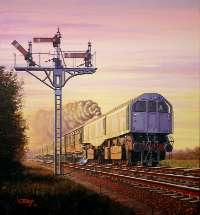
The painting depicts Oliver Bulleid's controversial and revolutionary design of steam locomotive, Leader, originally intended for use on the Southern Railway. The project was never completed, and 36001 was the only class member ever to actually steam. The loco was ultimately scrapped, along with the other class members, which were still at various stages of construction when the project was abandoned.
36001 never entered revenue-earning service. It was only ever used on test trains and trials during the development of the locomotives. 36001 usually always ran with a dynamometer car which can be seen behind the locomotive in the painting. This vehicle was the same one which recorded the world speed record with LNER A4 4-6-2 No.4468 Mallard on 3rd July 1938, and is now part of the National Collection at York.
The rather ugly appearance of these locomotives, comparable to the look of a diesel locomotive, stems from an attempt to construct a steam locomotive that could be driven from either end, negating the requirement for turning for return workings. In reality, 36001 was in fact turned during test runs so that the loco was only driven from No.2 end. This was because No.1 end was in close proximity to the smokebox of the internal boiler and made for very uncomfortable working conditions for the crew. This explains why the exhaust in the painting appears to be coming from the 'wrong' end of the locomotive.
I chose a low evening sun for the painting to add a bit of colour to the otherwise very unexciting grey livery of the locomotive. The composition was largely dictated by the need for it to be used as a book cover illustration.
This book, titled 'The Leader Project - Fiasco or Triumph?' (written by Kevin Robertson and published by Ian Allan), has just been released. Copies are available direct from Kevin Robertson: www.kevinrobertsonbooks.co.uk
The original painting is now part of a private collection in Cambridgeshire.
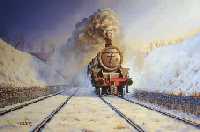
Stanier 'Black 5' No. 45056 storms out of Shotlock Hill Tunnel on the Settle and Carlisle line with a fitted-freight, sometime during the early 1960s.
This painting is available to buy for £695.00
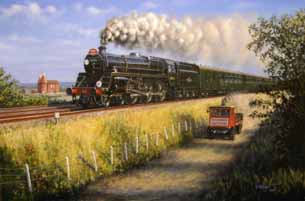
The train illustrated was based on a mainline rail-tour that operated along lines in Kent on the 4th September 2004. The train was named 'The Spitfire' and was promoted by the locally based Shepherd Neame Brewery. The locomotive is Standard Class 5 4-6-0 No. 73096, which normally runs on the Mid-hants railway.
The Sentinel steam lorry is based on a preserved example that was once operated by Shepherd Neame to transport hops from Oast Houses to the brewery.
This was a specially commissioned painting with the customer's inspiration coming from Terence Cuneo's 'Bentley Vs Blue Train' painting, hence the title.
The original painting is now part of a private collection in Kent.
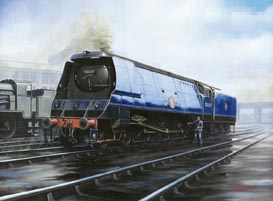
I've always liked the BR blue liveries that adorned many classes of express passenger locomotives during the formative years of British Railways following nationalisation in 1948. I've always thought that this livery suited the 'Merchant Navy' pacifics of the former Southern Railway particularly well. The pleasing shade of blue, together with the white-black-white lining (based upon the livery used by the Caledonian Railway), seemed to really set off the look of these locomotives.
The locomotive in this painting is 35029 'Ellerman Lines' which was eventually rebuilt into a more conventional form by BR. After withdrawal and subsequent disposal to the infamous Barry Scrapyard in South Wales, the locomotive was purchased by the NRM and is now a sectioned exhibit.
I have always enjoyed painting 'wet' scenes with puddles and interesting reflections. I am very much inspired by the work of Malcolm Root whose skill for imitating wet surfaces is second to none.
The original painting is now part of a private collection in Wiltshire.
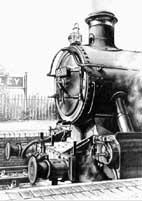
I enjoy using pencil to create high contrast images that manipulate light to create interesting images. I tend to use very soft grades of pencil (6B - 9B) to create the very darkest areas of drawings and use quite hard grades (4H - H) for subtle areas such as backgrounds and the smoke.
I have always noticed how, especially in hot weather, steam mingles around the steam pipes of locomotives and rolls up around the boiler. I've seen this when stood next to locomotives in stations, such as here with 1501 waiting to depart Arley with a passenger train to Bewdley on the Severn Valley Railway. I found replicating these effects of the steam and smoke to be very satisfying in this particular drawing.
The original pencil drawing is now part of a private collection in Hampshire.
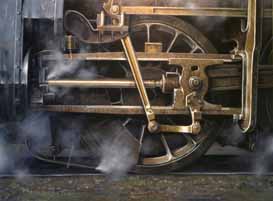
There is something that inspires me artistically about the dripping oil, swirling steam and layers of muck that collect around the working motion of steam locomotives. Together with the heat from the piston and cylinder, and the gentle hiss of escaping steam, the front end of a working steam locomotive quite literally drips and oozes atmosphere. And that wonderful aroma: a cocktail of smoke, steam and oil. If you can almost experience the smell when looking at this painting, then I have succeeded as an artist with this picture. The original canvas measures 40" x 30" which equates to the painting being a 1:3 scale depiction of the actual locomotive. This large scale was an attempt to pull the viewer into the picture making them feel as if they could almost reach out and touch the locomotive.
The original painting is now part of a private collection in San Antonio, Texas.
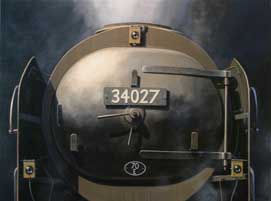
Bulleid Pacifics have one of the most distinctive 'faces' of all British steam locomotives. The none-circular shape smokebox door is unique to these classes and the frontal aspect always seems quite visually pleasing, hence the choice of composition with this painting.
The locomotive is Bulleid 'West Country' 4-6-2 No. 34027 'Taw Valley' which is preserved on the Severn Valley Railway.
The original painting is now part of a private collection in San Antonio, Texas.
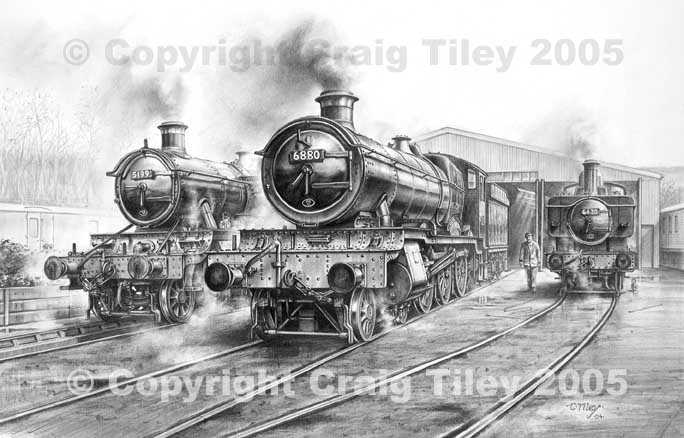
Drawn exclusively for the '6880 Betton Grange Project', this work is a vision that illustrates the group's aim to recreate an example of the extinct 'Grange' class of locomotive. In reality eighty members of this class were constructed by the GWR but none survived into preservation. The group is constructing the 81st member of the class, which the GWR planned to name 'Betton Grange'.
The project is based on the Llangollen Railway, and the drawing is of a scene set at Llangollen MPD. Alongside 6880 is No. 5199 which is a locomotive the project group has recently restored to working order. 6430 is another locomotive restored to working order for use on the Llangollen Railway.
Technically this drawing was very difficult. Since 6880 does not exist yet as a working locomotive, it was not physically possible to line the locomotives up for the drawing. Reference was made of both 5199 and 6430 because both these engines are in working order. The scene was then constructed from scratch, with each locomotive being individually drawn into the picture.
The original drawing is not for sale, but signed Limited Edition prints are available for £27.50.
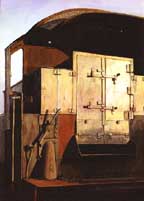
Some paintings come about as a result of a complete accident, and this is one of those. During an evening visit to the Bridgnorth headquarters of the Severn Valley Railway, I was walking around the yard when I happened to notice how the low golden sunlight had caught the tender from Ivatt 2-6-0 4MT No. 43106. With fading light all I could do was to quickly capture it with some photographs, from which the painting was produced. It is a very unusual subject for me, but is one of the most satisfying pictures I have completed. Also unusual is the title of this piece, which is derived partly from the locomotive's nickname of the 'Flying Pig' and that the painting describes the loco in a rather sorry state, requiring much work before it will be able to 'fly' again.
The original painting is now part of a private collection in Wiltshire.
Copyright © Craig Tiley
No images may be reproduced without the written consent of the artist